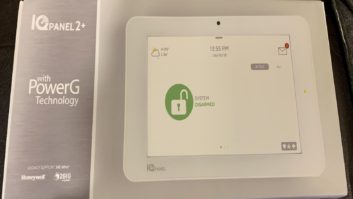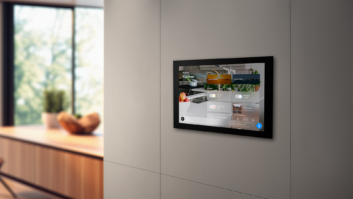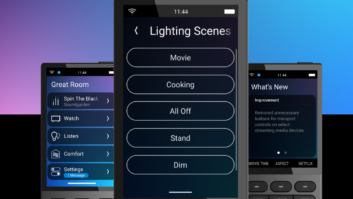The touchscreen is an ever-critical component of any home installation, but recent consumer trends– the ascent of the iPad and other mobile devices specifically–have altered the way home systems are controlled, or at least how we think about controlling them. Residential Systems spoke to manufacturers about their latest touchpanel technology and how the explosive mobile and tablet device market has affected their approaches to new product design.

Crestron’s TPMC-9L
URC’s KP-4000 two-way network keypad communicates with components through a residential IP network, so the KP-4000 can control pretty much everything on the network, including multi-zone AVRs, energy management tools, computers, iPods, and lighting. The KP-4000 can deploy second or third zones of an AVR, and it is programmed with URC’s Complete Control Program (CCP), which can program buttons to any size, color, or shape, as well as eliminate any buttons, text, or images that a homeowner may find confusing.

RTI’s RK10
URC will soon ship its Total Control line of touchpanels, but those details are still under wraps as this goes to press. The CCP products will continue to be sold through distribution while the Total Control will only be available through direct, certified dealers. URC’s Jon Sienkiewicz, director of marketing, did offer an explanation of the different capabilities that the next-generation touchpanels will have. “We’ve switched to the TCL programming language to create the application modules,” he said. “This allows us to create the modules much faster than before.”
As far as the mobile device market’s effect on URC’s touchpanels, “We haven’t changed anything,” Sienkiewicz said. “Our customers tell us that it’s fun to be able to use a mobile device under certain circumstances–like when they’re out on the deck and their remote control is inside their house. Microwave ovens are fun to use, too, but they can’t replace the kitchen range and traditional oven.”

URC’s KP-4000
As the latest addition to the Core 3 family of OSready touchpanels, Crestron’s TPMC-9L features a nine-inch widescreen and a larger display, yet it has a minimalist design. The touchscreen offers widgets and high-definition video streaming for IP/ web security cameras. Cover flow and page flips are two of the graphical, animated features. Fingerswipe control is enabled by gesture navigation with intelligent velocity. Pushbuttons are positioned along both edges of the screen, aligning screen text and graphics to the corresponding buttons.
For any Apple users, some of the TPMC-9L features may sound a little familiar. “Our latest touchpanels provide a user experience consistent with smart devices, and the panels feature infinity glass, no buttons, and very thin profile,” said Jeff Singer, Crestron’s marketing communications director.
“In 2004, we introduced the first WiFi touchpanel with an embedded OS that provided internet access, PC applications, and streaming media,” Singer said. “This was the predecessor to the smart devices we see today. So, when the iPhone and other devices were introduced, we already had the framework to integrate them into a Crestron environment.”
But Apple’s significant impact on the industry was further embraced at Crestron. “We modified the design and user interface of our latest touchpanels to be consistent with the iPhone/ iPad,” Singer noted.
He also said that Crestron devotes resources to expand control applications for iOS, Android, and Windows.

Honeywell’s Lynx Touch
The MVP-9000i, the newest member of AMX’s Modero touchpanel line, features wireless and wired functionality, interactive user interface capabilities like gestures and page transitions, nineinch widescreen 24-bit color display, and built-in 802.11a/b/g WiFi card with antenna diversity. Support for power over ethernet eliminates the need to pull a separate power cable for the docking station. A rough-in box allows the touchpanel to mount flush, recess in stone, drywall, brick, and most other surfaces.
“The MVP-9000i gives users the ability to seamlessly go from wired to wireless, so they get the best of both worlds,” said Lorelei Connon, senior product line manager for AMX. “They can use it while roaming the house, or dock it for use there. It transitions automatically.”
AMX is also embracing the tablet market with new products. “The booming smartphone and tablet computer market is driving advancements in lower power, higher-performance technologies, such as specialized processors, LCD screens, and high-performance batteries, [which] AMX is leveraging for new touchpanel development,” Connon said. “AMX is utilizing these advanced components to deliver new solutions, and at very compelling price points.”
Control4’s five-inch and seven-inch touchscreens feature a low profile and edge-toedge capacitive glass, which has made the biggest difference in Control4’s touchpanel technology, according to Paul Williams, vice president of support services. “It allows for quick response and better sensitivity,” he said.

Control4’s five-inch and seven-inch touchscreens
The touchscreens are operated by Control4 OS 2.0, which includes a flash-based user interface, and they can access and extend system capabilities using apps from the 4Store Application Marketplace. These touchscreens were designed specifically with dealers in mind; electricians can pre-wire the backboxes in new construction, so dealers can install them with a single3 connection.
This summer, Control4 has a license coming out for intercom functionality, providing wholehome communication. Users will be able to have conversations between rooms, send messages to all the rooms, and even monitor a baby room.
The multi-tiered impact of mobile and tablet devices has affected Control4’s approach to touchpanels and is reflected in the company’s latest designs, according to Williams. “The capacitive touch LCD glass first appeared in mobile devices. Secondly, the low price of these devices has reset the customer’s expectations of what touchpanels should cost. The days of selling multi-thousand dollar touchpanels has come and gone. Lastly, the sleek, slimline designs of mobile devices [have] set the customer’s expectation on what touchpanel devices should look like.”
Honeywell’s Lynx Touch is a seven-inch touchscreen supporting Z-Wave thermostats and lighting control. The menu-driven prompts are designed to be simpler and walk installers or homeowners through operation and configuration. Other features include two-way voice over GSM radio for homes without landlines, including VoIP houses. Lynx Touch works with Honeywell’s Total Connect remote management services. A Family Message Center allows users to leave voice messages for each other and function as a speakerphone.

AMX’s MVP-900i
Designed to take full command of a room’s environmental and information technology, RTI’s RK10 in-wall controller combines the power of a PC with the simplicity of an intuitive touchscreen control system. A 10.2-inch TFT widescreen LCD touch-screen and a fully customizable interface cater specifically to installations with many firsttime users. Communication options include a builtin wired and wireless ethernet connection for easy access to network security cameras, web browsing, programming, and full two-way communication with RTI XP series control processors.
“Two-way control via hardwired and wireless devices has been the biggest difference in our current line of touchpanels,” said Pete Baker, vice president of sales and marketing for RTI, “especially over our powerful 2.4-GHz ZigBee platform, which allows users to control and receive feedback from a variety of supported third-party systems and components, including HVAC, security, music servers, and much more.”
From the tablet market perspective, RTI offers a different view from some others, “Tablets and other mobile devices haven’t affected the design of our touchpanels,” Baker said. “If anything, they have actually magnified the benefits of having a dedicated professional control device with hard buttons for tactile control.”
Furthermore, Baker doesn’t believe touchpanels are vulnerable to a tablet takeover. “In addition to design, mobile devices have a number of limitations as primary controllers, from WiFi dependence to the lack of true multitasking,” he said. “Where they have influenced us is in the development of solutions such as our RTiPanel app, which complements our processors and touchpanels by providing users with convenient remote access to their electronic systems from anywhere in the world on their mobile devices.”
Embracing Change

The manufacturers interviewed about their touchpanel technology for this story had varying opinions on how mobile tablet devices affect their businesses. At this point, tablets are in their infancy, yet they have been tremendously influential in the home entertainment world, and their impact spans across the business spectrum.
In the case of Cortexa, the tablet revolution has led the home automation system supplier to cease developing new touchpanels altogether, and instead, offer an iPad dock and app. “We had been selling touchscreens for a long time,” said Jesse Lind, sales director for Cortexa. “They are expensive. It came down to cost and functionality. You get a lot more functionality out of the iPad.”
Cortexa’s in-wall iPad dock was launched about six months ago. The aluminum docks come in different colored bezels, brushed aluminum, and primed for painting. They mount either horizontally or vertically. With an MS RP of $399, “You can put two iPads and two docks in for the same price as one touchscreen,” Lind said.
Cortexa offers energy efficiency focused subsystem support including lighting, interior climate control, whole-home energy monitoring, whole-home audio and video entertainment, motorized shades, and security.
Touchpanels have been a significant part of Cortexa’s business, Lind said. “If someone was buying a controller, they were buying a touchscreen. That dropped pretty significantly when we came out with our iOS app. That led us into the iPad, putting it into the wall, and making it into a new touchscreen.”
Cortexa still stocks touchscreens, and Lind said they still sell limitedly, but mostly for very highend homes. Cortexa focuses more on the middle ground homeowners, “the average Joe,” Lind said.
Although Cortexa is banking on the increasing role of tablets in home control systems, Lind acknowledges the appeal of a dedicated touchscreen. “I think eventually [tablets] will be taking over. But at the same time, there’s still that sense of when you have a dedicated touchscreen in your wall, you know where it is and that it’s not going anywhere.”
Lindsey Snyder ([email protected]) is assistant editor of Residential Systems.






